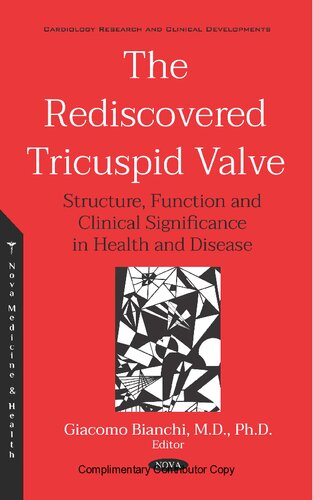(Ebook) The rediscovered tricuspid valve: Structure, Function and Clinical Significance in Health and Disease by Giacomo Bianchi, M.D., Ph.D. ISBN 2019947959
Tricuspid valve disease has long been ignored as a surrogate for the left atrioventricular valve (the mitral valve) and mainly a benign, indolent disease.
This concept is currently outdated, as we know that the pathology of the tricuspid valve, primitive or secondary, sometimes isolated, brings with it a poor prognosis if not treated. To date, the complexity is recognized not only of the valve itself, but also of its pathophysiology and the environment of the right heart and its interaction with the left heart. In order to better define the therapeutic path of a patient suffering from tricuspid valve disease, we have tried to offer a comprehensive overview to the reader, starting from historical considerations (Chapter 1) about the vision of the circulatory system and from the evidence accumulated over the centuries until the recognition of the continuum between signs and symptoms related to the valve.
As the basis of a modern approach to the understanding of the valve itself, we have traced the embryological and morphogenetic stages towards the anatomo-clinical correlates (Chapter 2). Subsequently, the epidemiology and clinical approach to tricuspid valve disease (Chapter 3) were illustrated, followed by the diagnostic procedure, state-of-the-art imaging techniques (Chapter 4) and more advanced techniques (Chapter 5). In particular, I thought it was necessary to dedicate a chapter to the pathology of the tricuspid valve secondary (functional) to left heart disease (Chapter 6), probably the most frequent form encountered by the clinicians. We have not neglected to discuss about tricuspid valve infections (Chapter 7), with particular reference to the microbiology, diagnosis and treatment.
We considered it necessary that the role of the valve in congenital adult disease should also be addressed (Chapter 8), whether in natural history, modified by surgery or as an acquired disease. Neoplastic pathology may also involve the valve and the pathologist provides (Chapter 9) the knowledge and systematization of the most frequent primary and secondary tumors. Coming to the therapeutic act, after dealing with special pathology of the valve, (Chapter 10) we present the pharmacological approach, a necessary act, sometimes as a sole therapeutic option and sometimes propedeutic to surgery.
Tricuspid valve plays an absolutely primary role in two aspects of the advanced treatment of refractory heart failure, namely its clinical and prognostic impact on ventricular care systems (LVAD) and cardiac transplantation (Chapter 11) has been discussed. The last two chapters are dedicated to non-medical treatment, with a particular focus on indications, risk selection and stratification as well as adequate surgical techniques (Chapter 12) and new perspectives of intervention through transcatheter techniques (Chapter 13).
Overall, there is a need for an integrated and multidisciplinary approach to a complex nosological entity that is itself interdependent on pathophysiological systems, which the clinician, cardiologist, cardiac surgeon, internist and researcher cannot ignore.
(Imprint: Nova Medicine and Health)
*Free conversion of into popular formats such as PDF, DOCX, DOC, AZW, EPUB, and MOBI after payment.


